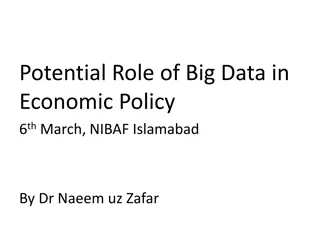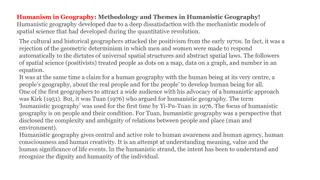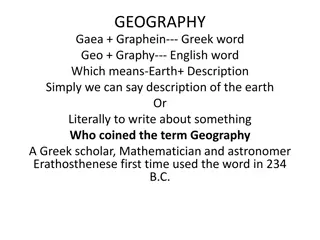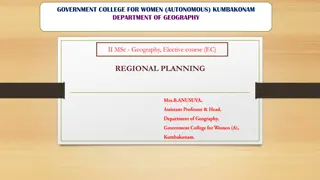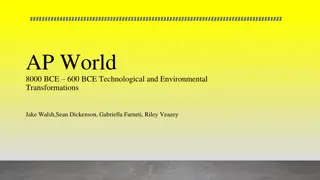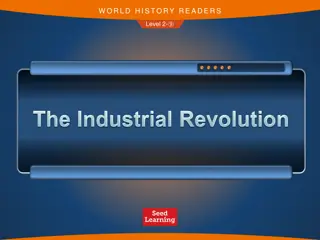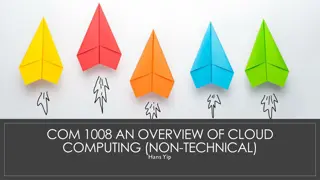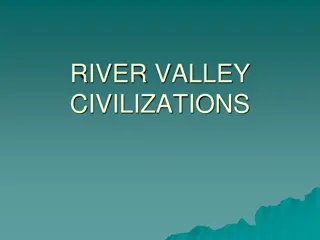Understanding Big Geography & Neolithic Revolution
Exploring the transformative periods from technology to environment changes up to c. 600 B.C.E, this content delves into the difference between religious myths and scientific accounts, the impact of the universe's vastness on human history, and the significance of the Neolithic Revolution in shaping early agricultural societies. It examines how societies evolved post-Ice Age, transitioning from hunter-gatherer lifestyles to settled communities, leading to societal complexity and inequality.
- Big Geography
- Neolithic Revolution
- Technology
- Environment Transformations
- Early Agricultural Societies
Download Presentation

Please find below an Image/Link to download the presentation.
The content on the website is provided AS IS for your information and personal use only. It may not be sold, licensed, or shared on other websites without obtaining consent from the author. Download presentation by click this link. If you encounter any issues during the download, it is possible that the publisher has removed the file from their server.
E N D
Presentation Transcript
THE TRUTH WILL SET YOU FREE Essential ?s 1.1, 1.2 & 1.3 Period 1: Technology & Environment Transformations, to c. 600 B.C.E.
KC 1.1: BIG GEOGRAPHY & THE PEOPLING OF THE EARTH 1. What is the difference between religiously based myths of origin and creation stories derived from scientific accounts? 2. How do modern notions of the immense size and age of the universe affect your understanding of human history? 3. What examples of comparison, connection & change in world history would you like to explore further as the course unfolds? 4. In what larger contexts might you place your own life history?
KC 1.1: BIG GEOGRAPHY & THE PEOPLING OF THE EARTH 1. Religious stories: seek to ANCHOR particular societies (their people) in a larger context. Sense of PLACE, PURPOSE & BELONGING. Science: claims are TRUER & more certain (literally). They can be checked & verified rather than accepted & believed. Much more concerned with HOW than WHY .
KC 1.1: BIG GEOGRAPHY & THE PEOPLING OF THE EARTH 2. Many find it disturbing to contemplate the scope of the universe. It has the tendency to reinforce sense of the INSIGNIFICANCE of human life. But our awareness as humans of the vast mystery of the universe makes us unique & can actually inspire in many people a sense of AWE.
KC 1.2: THE NEOLITHIC REVOLUTION & EARLY AGRICULTURAL SOCIETIES 1. In what ways did various Paleolithic societies differ from one another, and how did they change over time? 2. The Agricultural Revolution marked a decisive turning point in human history. What evidence might you offer to support this claim, and how might you argue against it? 3. How did early agricultural societies differ from those of the Paleolithic era? 4. Was the Agricultural Revolution inevitable? Why did it occur so late in the story of humankind? 5. The Agricultural Revolution provides evidence for progress in human affairs. How would you evaluate this statement?
KC 1.2: THE NEOLITHIC REVOLUTION & EARLY AGRICULTURAL SOCIETIES 1. They all shared a lifestyle of gathering & hunting, but after the last ICE AGE, many plants & animals thrived, providing a stable food source & the ability to settle down and form villages. These societies became more complex & larger with households, storage & unfortunately would lead to inequality.
KC 1.2: THE NEOLITHIC REVOLUTION & EARLY AGRICULTURAL SOCIETIES 2. Humankind was then able to support much larger populations, which led to human DOMINANCE on Earth. But it was part of a larger PROCESS that began long before the first permanent agricultural settlements took place.
KC 1.2: THE NEOLITHIC REVOLUTION & EARLY AGRICULTURAL SOCIETIES 3. Agricultural societies experienced greater social inequality than those of the Paleolithic era. Dense settlements & less mobile with more advanced technologies & techniques than the Paleolithic societies. Life & health WAS NOT much better though. Farming was hard work & nutrition was usually poorer than the Paleolithic counterparts. FAMINE was also a new issue to deal with if crops failed.
KC 1.2: THE NEOLITHIC REVOLUTION & EARLY AGRICULTURAL SOCIETIES 4. Only after the last Ice Age could it have been considered INEVITABLE. But it was part of a longer process of human exploitation, with techniques & technology that developed and the need to find people to develop them took a long period of TIME.
KC 1.2: THE NEOLITHIC REVOLUTION & EARLY AGRICULTURAL SOCIETIES 5. PROGRESS = population growth, dominance of humans over other life forms on the planet, explosion of technological innovations (pottery, weaving & metallurgy). On the other hand, social INEQUALITY, tribute payments, poor nutrition & new/deadly diseases are anything but progress.
KC 1.3: THE DEVELOPMENT & INTERACTIONS OF EARLY AGRICULTURAL, PASTORAL & URBAN SOCIETIES 1. How does the use of the term civilization by historians differ from that of popular usage? How do you use the term? Civilizations were held together largely by force. Do you agree with this assessment, or were there other mechanism of integration as well? How did the various First Civilizations differ from one another? Looking Back: To what extend did civilizations represent progress in comparison with earlier Paleolithic and Neolithic societies? And in what ways did they constitute a setback for humankind? 2. 3. 4.
KC 1.3: THE DEVELOPMENT & INTERACTIONS OF EARLY AGRICULTURAL, PASTORAL & URBAN SOCIETIES 1. Civilization implies SUPERIORITY, refined behavior of a higher form of society, as apposed to uncivilized , but in early civilizations we are MISSING the truly clear boundaries/borders & they might have just been more aware of differences & CONFLICTS than the other common people of their region.
KC 1.3: THE DEVELOPMENT & INTERACTIONS OF EARLY AGRICULTURAL, PASTORAL & URBAN SOCIETIES 2. The state used COERCION/threats to extract surplus products from farmers to support city people; but the state SOLVED widely shared problems & this earned these civilizations a measure of VOLUNTARY support.
KC 1.3: THE DEVELOPMENT & INTERACTIONS OF EARLY AGRICULTURAL, PASTORAL & URBAN SOCIETIES 3. In terms of government, it was LEGITIMATED RULE (Indus Valley was not power centralized). In terms of social hierarchy, it was SLAVERY & PATRIARCHY (in number & restrictiveness). In terms of writing, they were all fairly developed (Quipu was less sophisticated). In terms of technology, Chavin & Mesopotamia possessed less developed METALLURGY. In terms of urban living, Mesopotamia was more URBANIZED & Chavin possessed small cities.
KC 1.3: THE DEVELOPMENT & INTERACTIONS OF EARLY AGRICULTURAL, PASTORAL & URBAN SOCIETIES 4. In terms of PROGRESS, humans gained greatly (urban living, writing, calendars, monumental architecture) drove innovation, variety of goods & overall wealth. In terms of a SETBACK, humans suffered stark differentiations (class, slavery, warfare & wealth).



